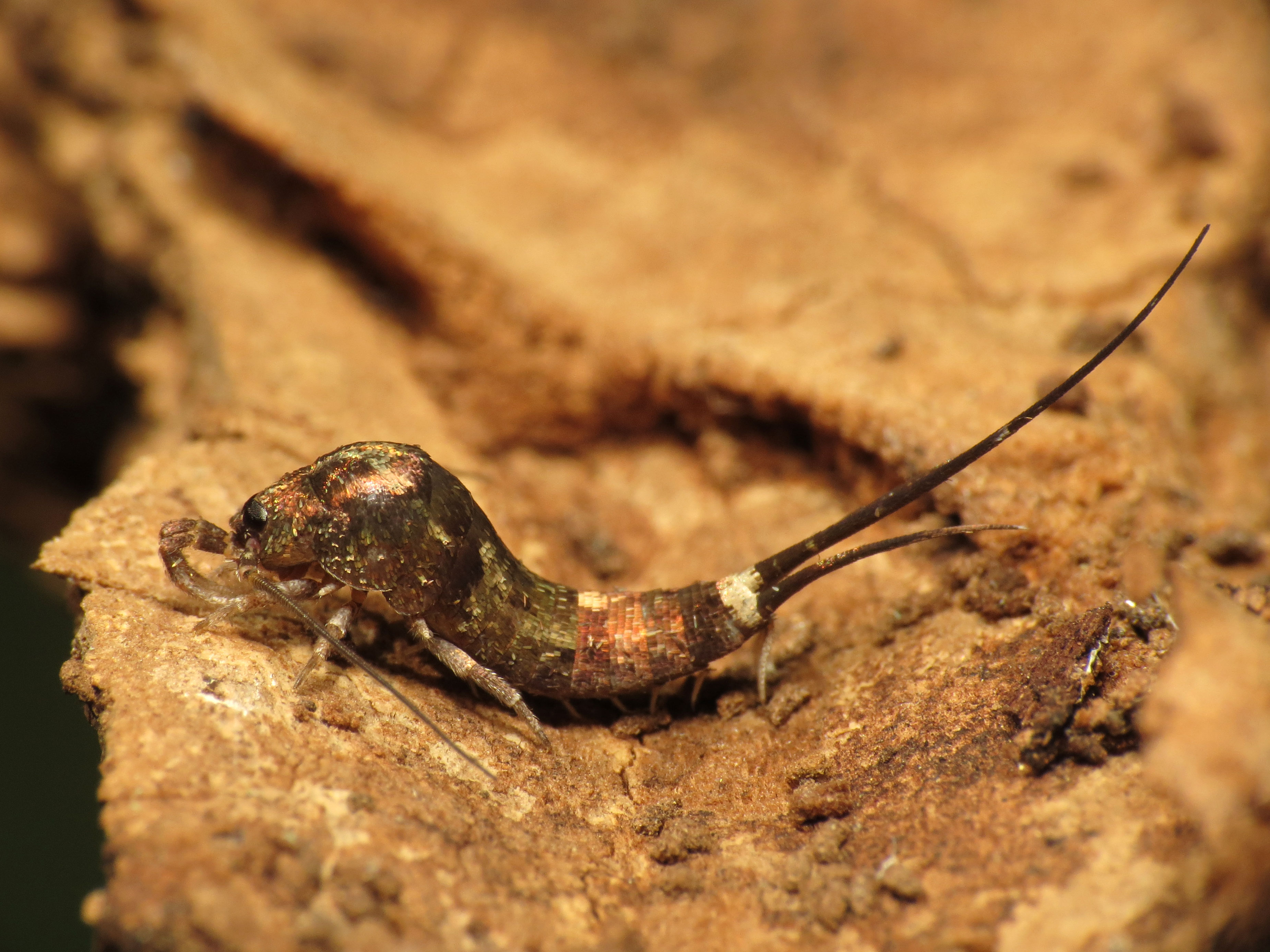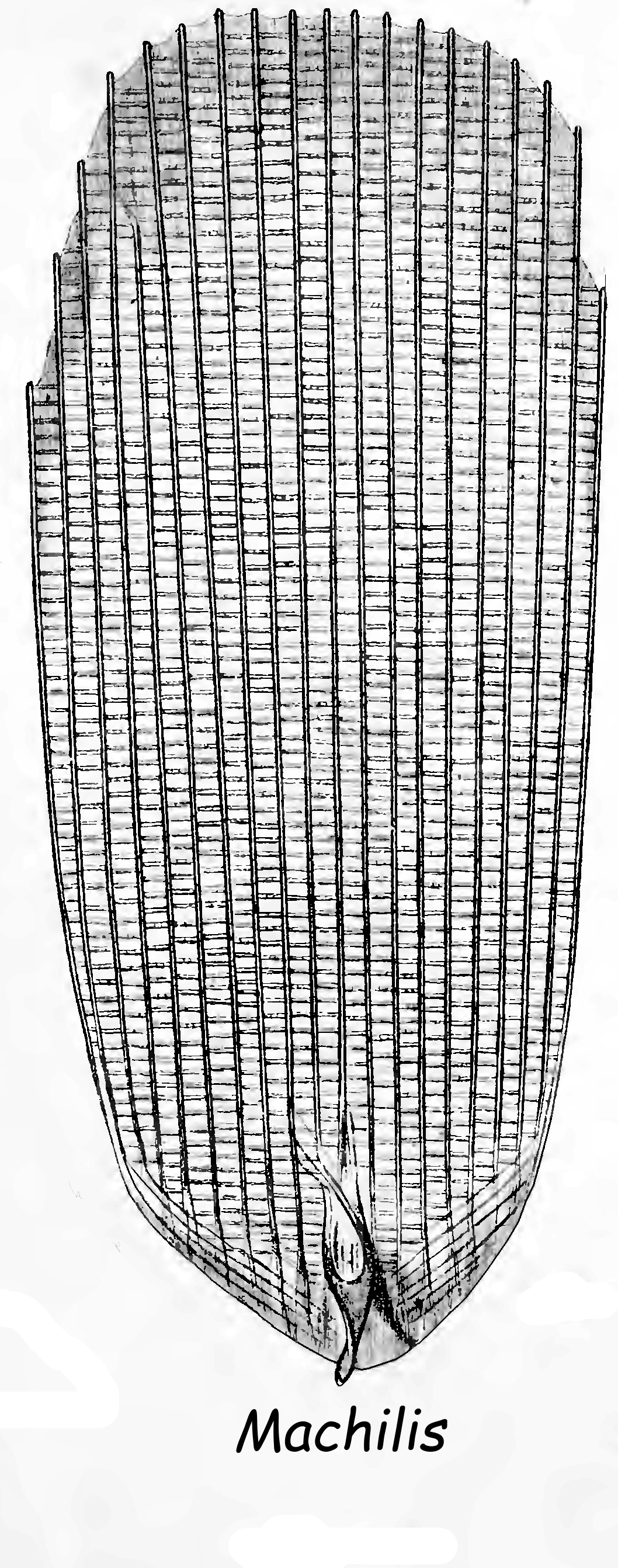Archaeognatha on:
[Wikipedia]
[Google]
[Amazon]
The Archaeognatha are an order of apterygotes, known by various common names such as jumping bristletails. Among extant
Proceedings of the 1st Dresden Meeting on Insect Phylogeny: “Phylogenetic Relationships within the Insect Orders”. (Dresden, September 19-21, 2003)
/ref>

 Further unusual features are that the abdominal sternites are each composed of three
Further unusual features are that the abdominal sternites are each composed of three
insect
Insects (from Latin ') are pancrustacean hexapod invertebrates of the class Insecta. They are the largest group within the arthropod phylum. Insects have a chitinous exoskeleton, a three-part body ( head, thorax and abdomen), three ...
taxa
In biology, a taxon (back-formation from ''taxonomy''; plural taxa) is a group of one or more populations of an organism or organisms seen by taxonomists to form a unit. Although neither is required, a taxon is usually known by a particular nam ...
they are some of the most evolutionarily primitive; they appeared in the Middle Devonian period at about the same time as the arachnid
Arachnida () is a class of joint-legged invertebrate animals (arthropods), in the subphylum Chelicerata. Arachnida includes, among others, spiders, scorpions, ticks, mites, pseudoscorpions, harvestmen, camel spiders, whip spiders and vinegar ...
s. Specimens that closely resemble extant species have been found as both body and trace fossils (the latter including body imprints and trackways) in strata from the remainder of the Paleozoic Era
The Paleozoic (or Palaeozoic) Era is the earliest of three geologic eras of the Phanerozoic Eon.
The name ''Paleozoic'' ( ;) was coined by the British geologist Adam Sedgwick in 1838
by combining the Greek words ''palaiós'' (, "old") and ''z ...
and more recent periods. For historical reasons an alternative name for the order is Microcoryphia.
Until the late 20th century the suborders Zygentoma and Archaeognatha comprised the order Thysanura
Thysanura is the now deprecated name of what was, for over a century, recognised as an order in the class Insecta. The two constituent groups within the former order, the Archaeognatha (jumping bristletails) and the Zygentoma (silverfish and fireb ...
; both orders possess three-pronged tails comprising two lateral cerci and a medial epiproct or ''appendix dorsalis''. Of the three organs, the appendix dorsalis is considerably longer than the two cerci; in this the Archaeognatha differ from the Zygentoma, in which the three organs are subequal in length. In the late 20th century, it was recognized that the order Thysanura was paraphyletic, thus the two suborders were each raised to the status of an independent monophyletic order, with Archaeognatha sister taxon to the Dicondylia
The Dicondylia are a taxonomic group (taxon) that includes all insects except the jumping bristletails (Archaeognatha). Dicondylia have a mandible attached with two hinges to the head capsule (dicondyl), in contrast to a hypothetical ancestral m ...
, including the Zygentoma.
The order Archaeognatha is cosmopolitan; it includes roughly 500 species in two families. No species is currently evaluated as being at conservation risk.
Description
Archaeognatha are small insects with elongated bodies and backs that are arched, especially over thethorax
The thorax or chest is a part of the anatomy of humans, mammals, and other tetrapod animals located between the neck and the abdomen. In insects, crustaceans, and the extinct trilobites, the thorax is one of the three main divisions of the cre ...
. Their abdomen ends in three long tail-like structures, of which the lateral two are cerci, while the medial filament, which is longest, is an epiproct. The tenth abdominal segment is reduced. The antennae are flexible. The two large compound eye
A compound eye is a visual organ found in arthropods such as insects and crustaceans. It may consist of thousands of ommatidia, which are tiny independent photoreception units that consist of a cornea, lens, and photoreceptor cells which disti ...
s meet at the top of the head, and there are three ocelli
A simple eye (sometimes called a pigment pit) refers to a form of eye or an optical arrangement composed of a single lens and without an elaborate retina such as occurs in most vertebrates. In this sense "simple eye" is distinct from a multi-l ...
. The mouthparts are partly retractable, with simple chewing mandibles
In anatomy, the mandible, lower jaw or jawbone is the largest, strongest and lowest bone in the human facial skeleton. It forms the lower jaw and holds the lower teeth in place. The mandible sits beneath the maxilla. It is the only movable bone ...
and long maxillary palp
Pedipalps (commonly shortened to palps or palpi) are the second pair of appendages of chelicerates – a group of arthropods including spiders, scorpions, horseshoe crabs, and sea spiders. The pedipalps are lateral to the chelicerae ("jaws") ...
s.
Unlike other insect orders, they don't have olfactory receptor-coreceptors ( Orco), which have either been lost or were never present in the first place.
Archaeognatha differ from Zygentoma in various ways, such as their relatively small head, their bodies being compressed laterally (from side to side) instead of flattened dorsiventrally, and in their being able to use their tails to spring up to into the air if disturbed. They have eight pairs of short appendages called styli on abdominal segments 2 to 9. Family Machilidae is also unique among insects in possessing small muscleless styli on the second and third thoracic legs. Similar stylets on the legs are absent in family Meinertellidae. They have paired eversible membranous vesicles through which they absorb water. There are nine pairs of spiracles; two pairs on the thorax, and seven pairs on abdominal segments 2 to 8. The pair of spiracles on the first abdominal segment has been lost./ref>


 Further unusual features are that the abdominal sternites are each composed of three
Further unusual features are that the abdominal sternites are each composed of three sclerite
A sclerite (Greek , ', meaning " hard") is a hardened body part. In various branches of biology the term is applied to various structures, but not as a rule to vertebrate anatomical features such as bones and teeth. Instead it refers most commonly ...
s, and they cement themselves to the substrate before molting. The body is covered with readily detached scales, that make the animals difficult to grip and also may protect the exoskeleton from abrasion. The thin exoskeleton
An exoskeleton (from Greek ''éxō'' "outer" and ''skeletós'' "skeleton") is an external skeleton that supports and protects an animal's body, in contrast to an internal skeleton (endoskeleton) in for example, a human. In usage, some of the ...
offers little protection against dehydration, and they accordingly must remain in moist air, such as in cool, damp situations under stones or bark.
Etymology
The name Archaeognatha is derived fromGreek
Greek may refer to:
Greece
Anything of, from, or related to Greece, a country in Southern Europe:
*Greeks, an ethnic group.
*Greek language, a branch of the Indo-European language family.
**Proto-Greek language, the assumed last common ancestor ...
, ἀρχαῖος, (''archaios'') meaning ancient and γνάθος (''gnathos'') meaning "jaw
The jaw is any opposable articulated structure at the entrance of the mouth, typically used for grasping and manipulating food. The term ''jaws'' is also broadly applied to the whole of the structures constituting the vault of the mouth and serv ...
". This refers to the articulation of the mandibles, which are different from those of other insects. It was originally believed that Archaeognatha possessed a single phylogenetically primitive condyle
A condyle (;Entry "condyle"
in
derived insects have two, but this has since been shown to be incorrect; all insects, including Archaeognatha, have dicondylic mandibles, but archaeognaths possess two articulations that are homologous to those in other insects, though slightly different.Blanke, A., Machida, R., Szucsich, N.U., Wilde, F. and Misof, B. (2015) Mandibles with two joints evolved much earlier in the history of insects: dicondyly is a synapomorphy of bristletails, silverfish and winged insects. ''Syst. Entomol.'' 40: 357-364. https://doi.org/10.1111/syen.12107 An alternative name, Microcoryphia, comes from the Greek μικρός (''mikros''), meaning "small", and κορυφή (''koryphē''), which in context means "head".
Archaeognatha
- Tree of Life Web Project
Virginia Polytechnic Institute and State College Department of Entomology {{DEFAULTSORT:Archaeognatha Insect orders Insects of the Arctic Middle Devonian first appearances
in
derived insects have two, but this has since been shown to be incorrect; all insects, including Archaeognatha, have dicondylic mandibles, but archaeognaths possess two articulations that are homologous to those in other insects, though slightly different.Blanke, A., Machida, R., Szucsich, N.U., Wilde, F. and Misof, B. (2015) Mandibles with two joints evolved much earlier in the history of insects: dicondyly is a synapomorphy of bristletails, silverfish and winged insects. ''Syst. Entomol.'' 40: 357-364. https://doi.org/10.1111/syen.12107 An alternative name, Microcoryphia, comes from the Greek μικρός (''mikros''), meaning "small", and κορυφή (''koryphē''), which in context means "head".
Taxonomy
Biology
Archaeognatha occur in a wide range ofhabitat
In ecology, the term habitat summarises the array of resources, physical and biotic factors that are present in an area, such as to support the survival and reproduction of a particular species. A species habitat can be seen as the physical ...
s. While most species live in moist soil, others have adapted to chaparral, and even sandy deserts. They feed primarily on algae, but also lichens, mosses, or decaying organic detritus.
During courtship, the males spin a thread from the abdomen, attach one end to the substrate, and string packages of sperm (spermatophores
A spermatophore or sperm ampulla is a capsule or mass containing spermatozoa created by males of various animal species, especially salamanders and arthropods, and transferred in entirety to the female's ovipore during reproduction. Spermatophores ...
) along it. After a series of courtship dances, the female picks up the spermatophores and places them on her ovipositor. She then lays a batch of around 30 eggs in a suitable crevice. The young resemble the adults, and take up to two years to reach sexual maturity, depending on the species and conditions such as temperature and available food.
Unlike most insects, the adults continue to moult after reaching adulthood, and typically mate once at each instar
An instar (, from the Latin '' īnstar'', "form", "likeness") is a developmental stage of arthropods, such as insects, between each moult (''ecdysis''), until sexual maturity is reached. Arthropods must shed the exoskeleton in order to grow or ...
. Archaeognaths may have a total lifespan of up to four years, longer than most larger insects.
References
External links
Archaeognatha
- Tree of Life Web Project
Virginia Polytechnic Institute and State College Department of Entomology {{DEFAULTSORT:Archaeognatha Insect orders Insects of the Arctic Middle Devonian first appearances